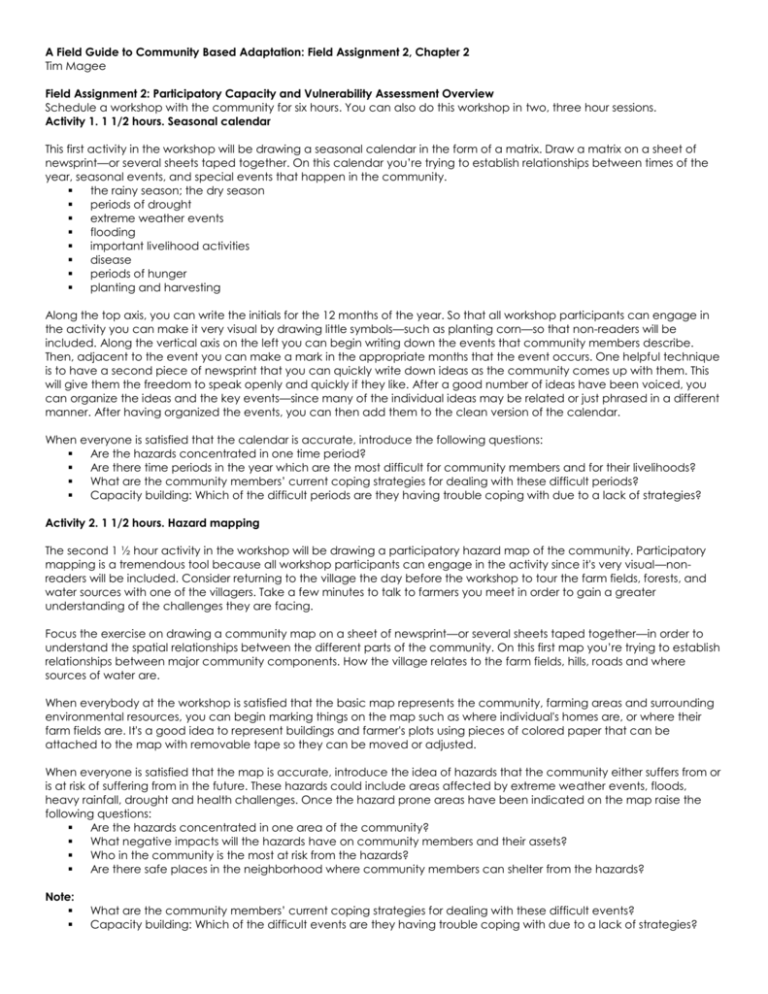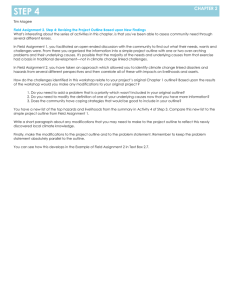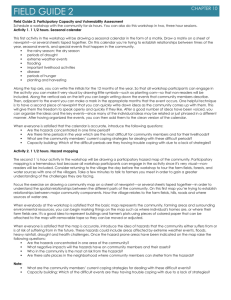
A Field Guide to Community Based Adaptation: Field Assignment 2, Chapter 2
Tim Magee
Field Assignment 2: Participatory Capacity and Vulnerability Assessment Overview
Schedule a workshop with the community for six hours. You can also do this workshop in two, three hour sessions.
Activity 1. 1 1/2 hours. Seasonal calendar
This first activity in the workshop will be drawing a seasonal calendar in the form of a matrix. Draw a matrix on a sheet of
newsprint—or several sheets taped together. On this calendar you’re trying to establish relationships between times of the
year, seasonal events, and special events that happen in the community.
the rainy season; the dry season
periods of drought
extreme weather events
flooding
important livelihood activities
disease
periods of hunger
planting and harvesting
Along the top axis, you can write the initials for the 12 months of the year. So that all workshop participants can engage in
the activity you can make it very visual by drawing little symbols—such as planting corn—so that non-readers will be
included. Along the vertical axis on the left you can begin writing down the events that community members describe.
Then, adjacent to the event you can make a mark in the appropriate months that the event occurs. One helpful technique
is to have a second piece of newsprint that you can quickly write down ideas as the community comes up with them. This
will give them the freedom to speak openly and quickly if they like. After a good number of ideas have been voiced, you
can organize the ideas and the key events—since many of the individual ideas may be related or just phrased in a different
manner. After having organized the events, you can then add them to the clean version of the calendar.
When everyone is satisfied that the calendar is accurate, introduce the following questions:
Are the hazards concentrated in one time period?
Are there time periods in the year which are the most difficult for community members and for their livelihoods?
What are the community members’ current coping strategies for dealing with these difficult periods?
Capacity building: Which of the difficult periods are they having trouble coping with due to a lack of strategies?
Activity 2. 1 1/2 hours. Hazard mapping
The second 1 ½ hour activity in the workshop will be drawing a participatory hazard map of the community. Participatory
mapping is a tremendous tool because all workshop participants can engage in the activity since it's very visual—nonreaders will be included. Consider returning to the village the day before the workshop to tour the farm fields, forests, and
water sources with one of the villagers. Take a few minutes to talk to farmers you meet in order to gain a greater
understanding of the challenges they are facing.
Focus the exercise on drawing a community map on a sheet of newsprint—or several sheets taped together—in order to
understand the spatial relationships between the different parts of the community. On this first map you’re trying to establish
relationships between major community components. How the village relates to the farm fields, hills, roads and where
sources of water are.
When everybody at the workshop is satisfied that the basic map represents the community, farming areas and surrounding
environmental resources, you can begin marking things on the map such as where individual's homes are, or where their
farm fields are. It's a good idea to represent buildings and farmer's plots using pieces of colored paper that can be
attached to the map with removable tape so they can be moved or adjusted.
When everyone is satisfied that the map is accurate, introduce the idea of hazards that the community either suffers from or
is at risk of suffering from in the future. These hazards could include areas affected by extreme weather events, floods,
heavy rainfall, drought and health challenges. Once the hazard prone areas have been indicated on the map raise the
following questions:
Are the hazards concentrated in one area of the community?
What negative impacts will the hazards have on community members and their assets?
Who in the community is the most at risk from the hazards?
Are there safe places in the neighborhood where community members can shelter from the hazards?
Note:
What are the community members’ current coping strategies for dealing with these difficult events?
Capacity building: Which of the difficult events are they having trouble coping with due to a lack of strategies?
Activity 3. 1 1/2 hours. Historical timeline
The Historical Timeline is one that is a very simple matrix with years in the left column and important events in the right
column. You are looking for insights into past hazards and events, and how they may have changed, intensified, or become
more frequent over time.
These could include hurricanes, droughts, epidemics, famines or floods. Other examples could include storms, erratic
rainfall, a change in the timing of the growing seasons and water availability. Hopefully, there will be village elders in the
workshop that will allow you to get a long-term perspective from 20 or 25 years ago so that you and the villagers can see if
these events are occurring more frequently.
Next, when the group has completed the timeline, introduce the subject of climate change into this timeline. Have they
seen a change over time with changes in climate? When did they start noticing the changes? Some examples:
beginning 20 years ago rainfall began diminishing; by how much?
beginning 20 years ago, the growing season changed; its shorter now—or it starts later.
beginning 20 years ago, the number of storms have increased and there is flooding when there didn’t used to be.
beginning 20 years ago, they've had to walk progressively further to get water. How much further?
Briefly describe the changes they have seen, how they've changed and over what time frame. Does the community realize
this is linked to climate change and realize that this may be ongoing and intensifying?
Note:
What are the community members’ current coping strategies for dealing with these difficult challenges?
Capacity building: Which of the challenges are they having trouble coping with due to a lack of strategies?
Activity 4. 1 1/2 hours. Matrix: Impact of hazards on livelihood assets and resources
The Vulnerability Matrix is another very simple matrix with important livelihood resources and assets in the left column and
important hazards in the first three activities in the top row. It's a good idea to prepare a blank matrix on newsprint in
advance. Doing a preliminary matrix on a sheet of notebook paper is also a good idea—you can then just organize and
transfer the information onto the clean, blank matrix.
INSERT TABLE 10.2 NEAR HERE
Table 10.2. Typical assets, resources and hazards
Important assets and resources may include:
income generation from agriculture
crop land
livestock
irrigation systems
health
food reserves/food security
environmental resources such as forests and
water
Typical hazards may include:
extreme weather events such as hurricanes or cyclones
drought/heat waves
unpredictable beginning and end to the rainy season
erratic rainfall or more or less rainfall
lack of water
shortage of food at specific times of the year
flooding
change in the timing of the growing season
health issues/disease
Once the matrix has been drawn with what the community feels are the most important hazards along the top row and
assets and resources which are the most vulnerable along the left column ask them to rank in terms of importance which
hazards are having the greatest impact on which resources. There are two ways that you can do this. Much like with needs
assessment, you could give each participant 15 counting stones, lay the matrix on the floor and let them vote. Or, you can
hold a discussion and let them rank the importance of hazard impact on resources and mark it on the matrix.
3 = greatest impact on the resource
2 = median impact on the resource
1 = low impact of the resource
0 = no impact of the resource
Please note what hazards they are facing and prioritize them by which are the most challenging for them. Note which
areas they feel the most vulnerable in and prioritize them.
At the end of this exercise you will have a matrix that prioritizes which hazards are causing the greatest risk and vulnerability
for which livelihood assets and resources. As a concluding exercise, discuss this prioritization with the participants and make
sure that they are an agreement.
Copyright © 2012, Tim Magee. All rights reserved.









